Biochar is made by heating biomass to a temperature of 400 – 800°C under the absence of oxygen. The process used is called pyrolysis. The resultant material is characterised by high specific surfaces of more than 300 m2 per gram, distributed over countless nano-, micro-and meso-pores. The ability of these pores to store water makes biochar a very efficient medium for storing moisture. The pores also trap large quantities of practically immobile air; with the result that biochar constitutes one of the best currently known insulation materials.
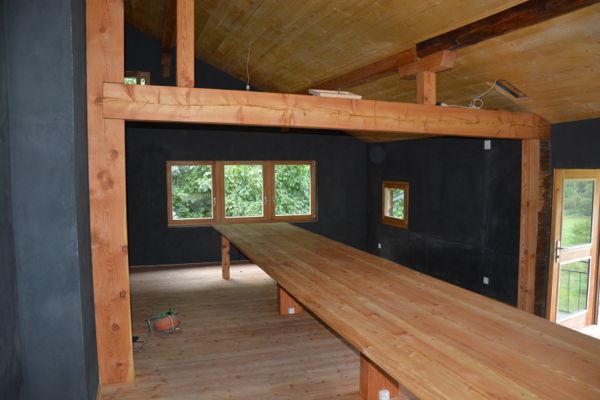
The building of the Ithaka Institute in Switzerland was the first to be restored using biochar plaster.
Two of biochar’s properties are its extremely low thermal conductivity and its ability to absorb water up to 5 times its weight. These properties mean that biochar is just the right material for insulating buildings and regulating humidity. In combination with clay, but also with lime and cement mortar, biochar can be used as an additive for plaster or for bricks and concrete elements at a ratio of up to 80%. This blending creates inside walls with excellent insulation and breathing properties, able to maintain humidity levels in a room at 45 – 70% in both summer and winter. This prevents not only that the air inside the rooms become too dry which is a potential cause of respiratory problems and allergies, but prevents also condensation from forming around thermal bridges and on outside walls which would lead to the formation of mold.
Biochar can be applied to the outside walls of a building using standard plaster spraying or rendering equipment. Applied at a thickness of up to 20 cm, it can be a substitute for Styrofoam. Through the use of biochar-based insulation material, houses can become very long-term carbon sinks, while at the same time providing a healthier indoor climate. And should such a house be demolished at a later date, the biochar-clay or biochar-lime plaster can be directly used as a compost supplement, thus continuing the carbon cycle in a natural way.
Such biochar-clay plasters adsorb smells and toxins, a welcome property in kitchens and for smokers. Alongside their use in housing, biochar-mud plasters are particularly suited for warehouses, factories and agricultural buildings as well as in schools, universities, hospitals and other rooms frequented by many people. It can also be assumed that an improved indoor climate has a positive effect on one’s ability to concentrate, for instance in meeting rooms, libraries, offices and classrooms. In addition, biochar is a very efficient absorber of electromagnetic radiation resulting from the use of both wireless technology and mains electricity.
.
How to make biochar-clay plaster
Biochar is added to a clay-sand mixture at a ratio of 30 – 50% (compared with normal clay plasters, the sand content is slightly lower). The biochar-mud mixture thus contains 50% biochar, 30% sand and 20% clay. This mixture can be used both for spray plastering and for conventional throw-on techniques. For the bottom and intermediate plaster layers it is recommended to also use larger-dimensioned pieces of biochar (diameter < 25mm), as this makes the plaster less likely to crack. To a great extent on account of the char, such plaster dries evenly and relatively quickly, with the result that – depending on a layer’s thickness – a further layer can be applied within 12 – 24 hours.
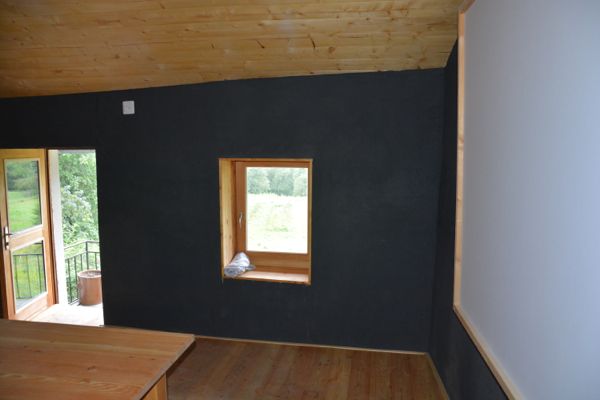
Lecture room at the Ithaka Institute
Finely ground char should be used for the top layer. The result is an anthracite-coloured plaster with a very noble, slightly shimmering appearance. Should a lighter colour be desired, the proportion of finely ground biochar can be reduced to 20-25% for the top layer, and mud-based paint applied as the final coating. Such plaster is easy to apply, using all conventional plastering methods. Compared to lime- or cement-based plasters, the biochar-clay mixture is not irritating to the skin of those applying it, meaning that gloves and protective clothing are not needed.
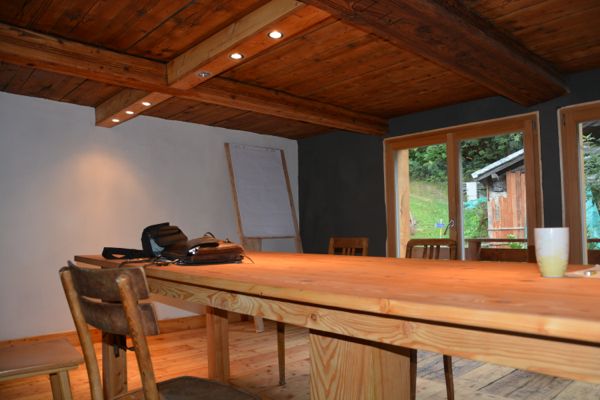
A biochar wall does not need to be black. Clay colors can even turn it into white.
Biochar can be mixed with conventional lime and cement plasters using the same ratio, and similarly used as an exterior coating. Here as well, such plaster provides good insulation, though its moisture storage capacity is reduced through the sealing of the top surface. However for plaster used indoors, mud is the recommended base material for achieving an optimal indoor climate.
The first buildings built or refurbished using this method include a wine cellar in Valais (Switzerland) and the seminar rooms and offices of the Ithaka Institute.
Biochar-clay plaster for wine cellars
The walls of an old Valais wine cellar were sprayed with a 10 cm thick layer of clay and biochar. This massive wall coating provides not only good thermal insulation and consequently lower temperature fluctuation, but is also a great humidity regulator.
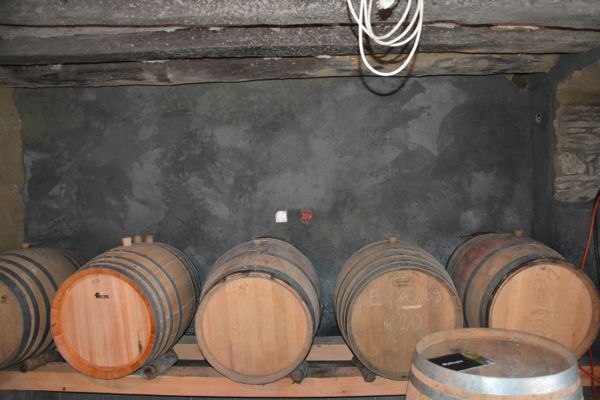
Wine cellar down under the Ithaka Institute.
In combination with the right passive ventilation, the machine-sprayed plaster is able to keep the cellar humidity level at a constant 60 – 80% throughout the year, thus preventing or at least greatly reducing the development of mold and other harmful microbes – an ideal environment for wine making. At higher humidity levels, the walls quickly adsorb moisture, returning it to the room just as quickly when humidity levels drop. While too high a level of humidity promotes the development of harmful microbes, too low a level is also not desirable, as it leads to particulate pollution, electrostatic charging of the air and the evaporation of wine in wooden barrels.
Thanks to its huge surface and porosity, the biochar in the mud plaster helps adsorb contaminants, spores and mycotoxins as well as helping to bind the gases produced during vinification. The latter aspect means that the molds and other bacteria lose their feeding grounds. Optimal humidity and the binding of toxins are perfect for promoting healthy microflora in the cellar, protecting the wine against sensory faults. The experience gained in the first winter season in the Valais test cellar shows that the humidity levels have remained constant at 65 – 75%.
Biochar-mud plaster for living quarters
The biochar-mud plaster technology developed by the Ithaka Institute to refurbish wine cellars can also be used for other rooms, such as food stores, animal housing or warehouses, as well as in homes, libraries, meeting rooms and schools. In homes and offices an optimal humidity level has a great influence on the comfort and health of people spending long hours in such rooms. A humidity level below 40% can lead to dry mucous membranes, in turn increasing the risk of colds, asthma and allergies. Similarly, a humidity level above 70% in closed living spaces results in increased exposure to mould spores. Applying just a 2 cm layer of biochar-mud plaster can noticeably improve a room’s climate.

Office of the Ithaka Institute. The white wall is made of a 7 cm biochar-clay plaster including tubes for wall heating.
Biochar-mud plaster can also be applied to walls made of plasterboard, as well as being used in more massive walls or for plastering over a wall heating system. The latter aspect is of particular interest, as wall heating systems provide very high levels of comfort, with the biochar-clay plaster acting as thermal storage, slowly radiating it’s warmth into the room. It is well suited for timber-framed walls as the biochar–clay excels in wood conservation.
Biochar bricks and concrete
First tests to produce biochar bricks using cement, lime or mud as a binder are very promising. With wet bulk densities under 1.2 g/cm3 and partly under 1 g/cm3 and a compressive strengths around 20 N/mm2, it would seem that a very exciting, highly functional lightweight material will soon be making its appearance. When using cement and lime, sand can be completely replaced by biochar reducing the weight of the material by factor 5 (see picture with the swimming bricks).

The biochar bricks are so light and aery that they swim. (brick trials and photo by Andreas Wittmann und Alexander Arns)
Sink City – or you may call it: Carbon Intelligent Cities (CIC)
Biochar is produced from plants, has no toxic effects and can be recycled at the end of its lifetime as a valuable soil conditioner. This means that whole cities could become carbon sinks and, at the end of several centuries, returned to nature in the form of compost. Instead of having to use special landfill sites for getting rid of contaminated building materials, we could be seeing tomatoes and potatoes growing on the remains of demolished houses.
Let’s start building SINK CITIES – with buildings made of wood, biochar, mud and lime, hemp, straw and wool. Instead of separating CO2 in the chimneys of coal- and gas-fired power stations and storing it underground (Carbon Capture and Storage – CCS), let’s instead store carbon in a meaningful and useful manner in the buildings of our cities. At the same time, let’s plant our cities so that at least 7-10% of city space is covered by flora. Let’s start using terra preta when planting new trees along streets, when creating green roofs and facades, when turning our balconies and even inside rooms into gardens. The photosynthetic performance of cities can easily be increased by a factor of ten. Cities can start producing and storing carbon, with the latent warmth in the water absorbed and evaporated by plants being used to provide cooling for overheated city walls. Why CCS? Why not smart C3S: Carbon Capture City Storage.
Positive effects of biochar plaster
• Humidity regulation
• Insulation
• Noise protection
• Binding of toxins (volatile organic compounds)
• Protection against electromagnetic radiation
• Less electrostatic charging
• Conservation of wood
• Less dust (mites!)
• Deodorant
• Aesthetic
• Anti-bacterial, fungicide
• Air-cleaning
The Ithaka Institute is currently conducting additional testing on our biochar plasters. We continue to work on optimizing both the product and the application methods and are developing different demonstration projects in Europe, North American and the developing world. Our intention is to identify partners in the green building materials industry to help deploy this exciting new material and to pair them with local or regional biochar producers to ensure appropriate biochar quality and to support the biochar industry as a whole in a sustainable manner. For enquiries about partnering on demonstration projects or rolling out our biochar based construction materials and methods, please contact the Ithaka Institute.
Supplement from Japan
In 2000, the fundamental law concerning the establishment of a recycling social system was enacted in Japan, and it was required to reuse any wastes as much as possible. The incineration of waste woods was particularly prohibited in order to reduce the discharge of CO2 and dioxin. The total amount of waste woods mainly from construction has reached to 4.6 million ton per year, but the domestic use is only 60 % still now. Therefore, some construction companies have switched from incineration to carbonization and intended to use the charcoal not only in agriculture but also for the humidity control of houses and buildings, because it is necessary to reduce the high humidity of buildings in Japan.
The function of charcoal for humidity control was studied intensively several decades ago (1) (2). Recently the construction companies have begun to spread the charcoal bag not only over the under floor but also above the ceiling (3). Meanwhile it was also reported that the treatment was efficient to reduce asthma and atopic dermatitis by diminishing the population of molds and ticks (4) (5).
With the development of charcoal utilization, carbonization technology is developing from the simple kiln to the automatic mass production facilities. The newly devised carbonizers including various kinds of movable batch type kiln, rotary kiln, swing kiln and etc has been sold for the mass production of waste wood charcoal. In some cases the extra gas has been used for thermal electric power generation. At the same time, the studies to establish the industrial standards and function of carbonized materials have started, and the charcoal industry begins to be renewed in the 21st century.
(Thanks to the Japanese Biochar Association)
(1) Nakano T. et al. (1996) Improvements of the under floor humidity in woody building and water content of wood material. Mokuzai Kogyo 51(5): 198-202 (in Japanese)
(2) Abe I. et al. (1995) Humidity control capacity of microporous carbon. Seikatu Eisei 39(6): 333-336 (in Japanese)
(3) Kitamura T. (2005) Evaluation of the humidity control capacity of the waste wood charcoal. J. Mat. Cycle & Waste Manage. 16(6): 501-507 (in Japanese)
(4) Morita H. (2005) The effect of humid controlling charcoal on the environmental antigenic allergy. Proceedings of 35th Annual Meeting of Japanese Society for Dermatoallergology: 115.
(5) Taketani T. (2006) Evaluation of the effect of humid controlling charcoal on the infantile bronchial asthma. Allergy 55(3, 4): 467

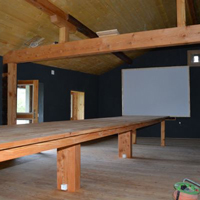
Very interesting
I was thinking along similar lines in the past about using charcoal in building. I had done some research on charcoal as an insulator and found that it rapidly absorbs moisture from the air. My impression at the time was that the moisture could strongly affect it's insulative properties. I don't recall the details, but whatever I found was enough to put me off that line of inquiry at the time. Charcoal might not be a good thermo-conductor, but water ain't so bad. Do you have an idea of how the absorption of moisture affects the insulation value? Also, where are you using it, or proposing to use it, that low thermal conductivity would be used to high advantage? What about dusting on those black walls? That can be a problem with clay plasters. What if someone rubs against it? It does seem like it might improve air quality and energy quality of a room. Finally, how is it that charcoal affects electromagnetic radiation? Is it because it is somewhat conductive? If so, grounding the walls to earth with wire might enhance the effect.